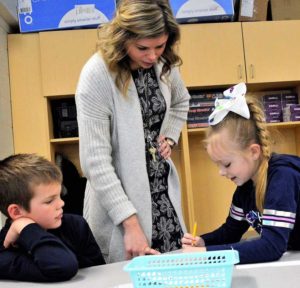If the words “computer coding” immediately make your brain freeze up, take it from these third-graders: It doesn’t need to be that hard.
Two dozen of them learned the basics in Paige Carleton’s classroom at Alpine Elementary School, their first steps in a new effort this semester to reach all Kenowa Hills elementary students with STEM: science, technology, engineering and math.
Sound like a bunch of keyboards and wires? That comes later. First, students learned the difference between algorithms – the list of steps needed to complete a task – and programming – the visual representation of those steps. And they did it with good old paper and pencil.

Working in pairs, one student gave directions for the other to fill in on a checkerboard-style grid. In so doing, one was controlling the other’s “automatic realization machine” – you guessed it, their ARM.
“Left, left, left, color,” Malachi Kukla instructed Gianna Holleman, who dutifully moved her pencil across three squares then filled one in. “Up, up, color,” Malachi went on, and Gianna obliged.
Far from being intimidated by STEM, these students seemed to be thoroughly enjoying their introduction to the high-tech world with low-tech tools.
“It’s like hypnotizing people,” said Ethan Newman, after sort-of hypnotizing Jacey McEwen into filling in her grid. “You’re telling them what to do and they’re actually doing it.”
He has loftier goals than being a hypnotist, however: “I want to be an engineer when I grow up. I want to work on cars” – BMWs, specifically.

Finding the Fun
Ethan’s career vision is one of many that Kenowa Hills students could contemplate, aided by the new program aimed at preparing them for more advanced STEM work in middle school. It’s one of five “specials” classes all students take once a week, along with art, music, physical education and Spanish.
The STEM component was funded partially by existing grants and partially by the countywide enhancement millage passed by voters last year. Pre-election polling by Kent ISD “revealed the importance of this experience for our students,” said Mike Burde, Kenowa Hills assistant superintendent, adding Kent ISD provided consulting to help start the program.
The 45-minute classes are being taught at Central by Delia Bush, a 16-year teacher at Kenowa Hills, and Carleton, who was hired this semester. A former middle school science teacher, Carleton aims to instill her students with enthusiasm for science and technology — subjects she said she found boring until a high school chemistry teacher unlocked the magic.

“I love science, I love STEM,” said Carleton, who hopes her students find fun in experiments, building things and learning by trial and error. “I want them to get excited for STEM and learn the vocabulary, so they can go home and say ‘I know what an algorithm is.’”
Besides computer coding, the classes also cover robotics, design engineering and electronics, the latter aided by a supply of Little Bits, handy mini-building blocks for inventions. In a district report on the program, Bush described using Little Bits with her students: “their faces beamed when they completed a circuit and made it light up.”
Given the rapid evolution of technology and still-developing career fields, there’s no telling where students’ skills in problem-solving and collaboration will take them, said Alpine Principal Jason Snyder: “We’re trying to prepare them for jobs that don’t exist.”
CONNECT













